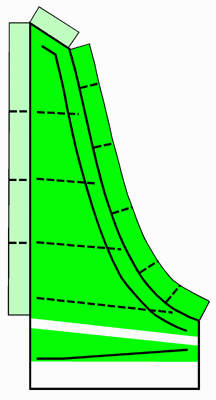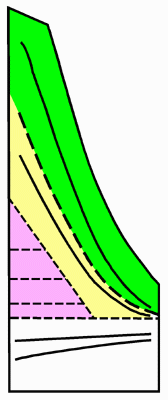The Soundboard of a Harpsichord
If you look at solely the physical dimensions of harpsichord soundboards and the variety of properties
of the wood of which they are made, you will see so many variables that it is easy to give up trying to
understand them. But there is another way of looking at soundboards - from the view of a harpsichord string.
A string is a chunk of isotropic gunk (isotropic: a material with the same properties in all three dimensions).
Nothing could be further from living things like wood than metal is!
Any view of the universe a metal string has is going to be childishly simple by comparison with ours.
And so, the smart question is to ask, how does a string view a soundboard? Well, it sees a mass (weight,
sort of) and compliance (give). That is what affects the frequency at which the string will
vibrate and how much of its energy is coupled to (in common with) the soundboard. And, it sees an acoustic
damping, which determines how fast its energy is dissipated into the surrounding world after it is plucked.
All instrument makers know this at heart. Get any of us in a workshop,
and the first thing we do with any soundboard - harpsichord, guitar, violin, whatever - is to tap it to see
if it sounds 'alive', to ensure that the sounds of a string will be sent to the surrounding air rather
than all soaked up in dead wood. Then we heft it to judge its weight and bend it to judge its flexibility.
Maybe, some day, I'll figure out how to communicate the aliveness we look for in words, but the truth is that I
spent an afternoon with Sydney Evans, a luthier supplier in England when I was there. At the end of the afternoon,
after picking up a few hundred pieces of various qualities of violin wood, I knew the feel and have never forgotten.
However, mass and compliance are things on which one can put
numbers.
And, one can relate those numbers to several
important things about soundboards. In particular, they are related to the direct-sound sustain of the instrument,
to the coupling between plucked and unplucked strings, and to the frequency response (warmth) of the sound. The
first study I am aware of in this vein was done by Fletcher (Acustica 37:139 1977). One of Fletcher's conclusions
was that the traditional barring design of northern harpsichords
should result in a very even frequency response from the fundamental resonance up to about 4 kHz. This was
confirmed by Kottick (Scientific American 264(2):110-115 1991) who observed an average resonance spacing of
17 Hz in a new instrument, closer than the width of the individual resonances. However, when Kottick measured
old instruments (GSJ 38:55-77 1985) he found much more variable response - most had at least one very strong peak
in the octave below c', and response dropped off rapidly above 1 kHz. I suspect that when these old
instruments were new, their makers were aiming for a more even and brilliant response than we hear from them today.
|
There are two basic designs in old harpsichord soundboards. The model used by most Italian instruments was
to put bars across the underside of the soundboard (dashed in the diagram at right), so that the string is
connected to as large a sounding area as possible (green at right - the light green shows area that is only
coupled to the soundboard by the internal air resonance). The ends of the soundbars are tapered, and the
sides of Italian instruments are of the same construction as the soundboard, flexible between the 'barring'
provided by the support knees. The soundbars usually seem to be placed to meet the bentside between knees,
but to come close to them on the spine. Older instruments tend to have fewer and lighter
soundbars than later ones. The entire soundboard of such an instrument moves up and down, and the bentside
between the knees in and out, in response to a string vibration. One essential function of Italian soundbars
is to establish a slight curvature (crown) to the soundboard. If the soundboard were flat,
it would pull in the sides both when moving above center and below center - the sides would vibrate at twice
the frequency of the soundboard. With a crown, the sides always move in when the soundboard moves up, and
move out when the soundboard moves down, with no frequency doubling.
The lower the frequency, the larger the area is required to couple a soundboard to air. Being almost entirely
soundboard, the sound of Italian instruments has lots of fundamental, especially the low frequency
drum-like pulse of the initial pluck. In isolation, the sound of an Italian string would be quickly coupled
to the surrounding air and thus die away quickly, but another factor comes into play. The sections of string
between bridge and hitchpin were not wrapped in felt as with modern pianos, so they are set into resonance
by the pluck of the sounding string. Due to the light soundboard and flexible sides, these string ends can
radiate sound very effectively. In fact, in many early Italians the nut was placed on a soundboard of its own
as in this diagram - the string ends between nut and tuning pin could radiate effectively too. So, a good
Italian instrument has a powerful fat direct sound (ictus) that is rapidly transformed into a cathedral-like
'echo' from the sympathetic strings.
|

|
|
The model used by northern instruments was fundamentally different. The bottom and sides are rigid and heavy.
Frank Hubbard once made a series of Flemish instruments with cases that included ones made of Douglas fir
plywood, and insisted that the only difference in the sound was that the plywood was better in the sense
that, being more stable than solid wood, it permitted the soundboard to be made more responsive. The northern
soundboard is unbarred under the bridge so it sounds in the manner of a harp, as a thin membrane. No crown is
required acoustically as with the Italian design. (They are, however, put in under compression to avoid splitting
with weather changes under the constraint of the rigid sides.) The primary width of this harp-like soundboard
(green at right) is set by a 'cutoff' soundbar that
is roughly parallel to the bridge. In instruments with a 4' stop, this first bar (dotted at right, between the
yellow and green areas) is the hitch rail for the 4' strings, then the 4' soundboard (yellow)
has its own cutoff bar. The soundboard in the triangular area defined by this bar (in magenta) has a few more
soundbars to divide it up a bit irregularly so that it has lots of the plate resonances shown in Kottick.
The nuts are on a rigid wrestplank, so the string ends at the tuning pins are acoustically inactive.
And, the string ends between 8' bridge and hitchpin can only radiate from one end, not from both as with the
Italian design. In effect, their place is taken by the triangular section of the northern soundboard.
The northern soundboard can be made more acoustically
rigid than the Italian model, so the sound of a northern string can have less ictus and sustain longer
directly, that is by itself rather than via the sympathetic vibration of the string ends. However, the
cathedral-like echo of the Italian was still valued in the north - several northern makers used side-string
(mouse-ear) dampers that did not touch the string when the choir was not being plucked, which gave a
similar effect as the Italian end strings when at least one choir was off.
|

|
For music of rapidly changing tonality, especially to remote keys, the northern sound adapts faster,
it's 'cleaner', more precise tonally than the Italian. But the richness of a cathedral sound is
magnificent, when used for music whose tonal character matches it.
John Sankey
other notes on instrument making

